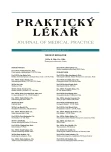Evaluation of needs of terminally ill patients in home care: a pilot study
Authors:
R. Bužgová; G. Macháčková
Authors‘ workplace:
Vedoucí: doc. PhDr. Darja Jarošová, PhD.
; Ústav ošetřovatelství a porodní asistence
; Lékařská fakulta
; Děkan: doc. MUDr. Arnošt Martínek, CSc.
; Ostravská univerzita, Ostrava
Published in:
Prakt. Lék. 2012; 92(2): 111-116
Category:
Of different specialties
Overview
Evaluation of the needs of terminally ill patients in home care is an important indicator of the quality of care that is being provided. The aim of the research was to determine the bio-psycho-social and spiritual needs of terminally ill patients in home care with regards to their quality of life. Furthermore to determine the degree of importance of needs and level of their saturation by health workers. Questionnaires were used for data collection:
- for needs assessment – PNPC (Problems and Needs in Paliative Care questionnaire),
- for quality of life – EORTC QOL – C30, and
- psychic state – HADS scale – (Hospital anxiety and Depressed Scale).
Patients reported the following needs to be important and also insufficiently addressed:
- fatigue,
- sleeping problems,
- pain,
- ability to concentrate,
- to cope with the disease and with changes in the body,
- to have an activity-filled day.
The relationship between the saturation of needs and quality of life was only detected in the physical needs (p<0.05). Patients who felt that physical needs are insufficiently saturated simultaneously reported a lower overall quality of life.
Key words:
home care, quality of life, needs, dying.
Sources
1. Currow, D.C., Agar, M., Sanderson, Ch., Abernethy, A. Population who die without specialist palliative care: does low uptake equate with unmet need. Palliat. Med. 2008, 22(1), p. 43-50.
2. Fayers, P.M., Aaronson, N.K., Bjordal, K. et al. The EORTC QLQ-C30 Scoring Manual (Third edition). Brussels: EORT C Quality of life Group, 2001, 86 p.
3. Fitzsimons, D., Mullan, D., Wilson, J.S. et al. The challenge of patients’ unmet palliative care needs in the final stages of chronic illness. Palliat. Med. 2007, 21(4), p. 313-322.
4. Johnsen, A.T., Petersen, M.A., Pedersen, L., Groenvold, M. Symptoms and problems in a nationally representative sample of advanced cancer patients. Palliat. Med. 2009, 23(6), p. 491-501.
5. Kalvach, Z. Umírání a paliativní péče v ČR (situace, reflexe, vyhlídky). 1. vyd. Praha: Cesta domů, 2004. 1003 s. ISBN 80-239-2832-5.
6. Malíková, E. Péče o seniory v pobytových sociálních zařízeních. 1. vyd. Praha: Grada, 2011. 168 s. ISBN 978-80-247-3148-3.
7. Osse, B., Vernooij-Dassen, M., Schadé, E., Grol, R. A practical instrument to explore patients´ needs in palliative care: the Problem and Needs in Palliative Care questionnaire. Palliat. Med. 2007, 21, p. 391-399.
8. Peters, L., Sellick, K. Quality of life of cancer patients receiving inpatient and home-based palliative care. J. Adv. Nurs. 2006, 53(5), p. 524-533.
9. Quill, T.E., Lo, B., Brock, D.W., Meisel, A. Last-resort options for palliative sedation. Ann. Intern. Med. 2009, 151(6), p. 421-424.
10. Sláma, O., Kabelka, L., Vorlíček, J. a kol. Paliativní medicína pro praxi. Praha: Galén, 2007. 362 s. ISBN 978-80-7262-505-5.
11. Svatošová, M. Hospice a umění doprovázet. Praha: Karmelitánské nakladatelství, 2008. 115 s. ISBN 978-80-7195-307-4.
12. Svatošová, M. Sociální práce s lidmi umírajícími v hospici. In Matoušek, O., Koláčková, J. Sociální práce v praxi. Praha: Portál, 2010, s. 195-210.
13. Tomagová, M., Bóriková, I. Potřeby v ošetřovatelství. Martin: Osveta, 2008. 129 s. ISBN 978-80-8063-270-0.
14. Zacharová, E., Hermanová, M., Šrámková, J. Zdravotnická psychologie - teorie a praktická cvičení. Praha: Grada, 2007. 232 s. ISBN 978-80-247-2068-5.
Labels
General practitioner for children and adolescents General practitioner for adultsArticle was published in
General Practitioner

2012 Issue 2
Most read in this issue
- Gluten enteropathy
- Subliminal perception, medicine and addictive diseases
- Primary prevention in general practitioner surgeries
- Electronic documentation for nursing diagnostics in home care
